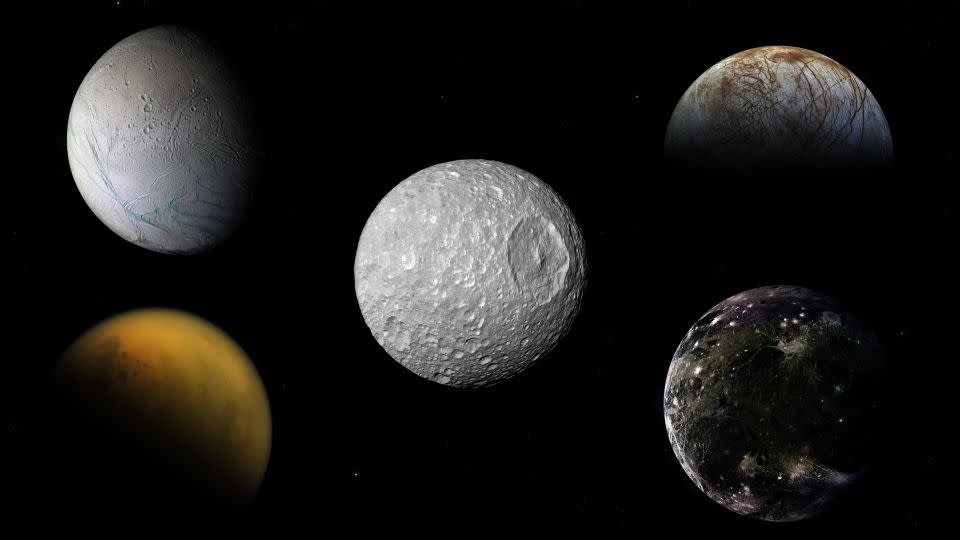Sign up for CNN’s Wonder Theory science newsletter. Explore the universe with news about fascinating discoveries, scientific developments and more.
Astronomers have found additional evidence that one of Saturn’s smallest moons, Mimas, hides a global ocean beneath its icy surface. Building a stronger case for the presence of water – essential to life as we know it – could help scientists gain a better understanding of where to look for habitable worlds in the vast expanses of deep space.
Scientists previously thought Mimas was just a large chunk of ice before NASA’s Cassini mission studied Saturn and some of its 146 moons by orbiting the ringed planet between 2004 and 2017.
Mimas was discovered in 1789 by the English astronomer William Herschel as a small speck near Saturn and was first imaged from space by the Voyager probes in 1980. Craters cover Mimas’ surface, but the largest is 80 miles wide and causes the moon to resemble the Death Star from the “Star Wars” movies.
Data collected during Cassini flights past Mimas intrigued astronomers. The moon takes just over 22 hours to orbit Saturn and is only about 116,000 miles from the planet. The Cassini data showed that Mimas’ rotation and orbital motion underwent changes caused by the moon’s interior.
A team of European researchers determined in 2014 that a rigid, elongated and rocky core or subsurface ocean caused the moon’s rotation and movement.
As a follow-up to the previous study, astronomer Dr. Valéry Lainey of the Observatoire de Paris and his colleagues looked at the orbital motion data to see which scenario was most likely. The findings were published on Wednesday in the journal Nature.
The team determined that the moon’s rotation and orbital motion did not match Cassini observations if Mimas had a pancake-shaped rocky core. Instead, the evolution of Mimas’ orbit over time suggested that an internal ocean shaped its motion, Lainey said.
“This discovery adds Mimas to an exclusive club of moons with internal oceans, including Enceladus and Europa, but with a unique difference: the ocean is remarkably young, estimated to be only 5 (million) to 15 million years old,” said co-author of the research. Dr. Nick Cooper, honorary researcher in the astronomy unit of the School of Physical and Chemical Sciences at Queen Mary University of London, said in a statement.
Old surface, young ocean
The research team determined the origin and age of the Mimas ocean by studying how the moon, with a diameter of about 400 kilometers, responded to the gravitational pull exerted on it by Saturn.
“Internal heating must come from the tides that Saturn produced on Mimas,” Lainey said. “These tidal effects have caused friction in the satellite, which releases heat.”
The team suspects that the ocean is about 20 to 30 kilometers deep beneath the moon’s ice layer. With the ocean being so astronomically young, there would be no outward signs of surface activity to indicate the presence of a subsurface ocean.
The craters across Mimas act like telltale ripples, indicating an ancient surface. But Saturn’s Enceladus appears younger because active geysers have helped resurface or deposit new, fresh material on that moon’s surface.
The ocean is still evolving, so Mimas could provide unique insight into the processes behind how subsurface oceans formed on other icy moons, the researchers said.
A closer look at ocean worlds
The discovery could change the way astronomers think about moons in our solar system.
“If Mimas hides a global ocean, that means liquid water could be just about anywhere,” says Lainey. “We already have serious candidates for global oceans (on moons like) Callisto, Dione and Triton.”
In 2017, NASA announced that ocean worlds may be the most likely places to find life beyond Earth, and missions such as the European Space Agency’s Juice and NASA’s Europa Clipper and Dragonfly will explore the potential habitability of Jupiter’s moons Europa, Ganymede and Callisto. Saturn’s moon Titan.

“The existence of a recently formed liquid water ocean makes Mimas an excellent candidate for research for researchers investigating the origins of life,” Cooper said.
It may be time to observe other seemingly quiet moons in the solar system that could hide conditions that could support life, the study authors said.
“Lainey and colleagues’ findings will motivate a thorough investigation of medium-sized icy moons throughout the Solar System,” wrote Drs. Matija Ćuk and Alyssa Rose Rhoden in an article accompanying the study. Ćuk is a research scientist at the SETI Institute in California, and Rhoden is chief scientist at the Planetary Science Directorate at the Southwest Research Institute in Colorado.
Neither author was involved in the study, but Rhoden has researched the potential for a ‘stealth’ ocean on Mimas.
“The difference between our 2022 paper and this new paper is basically that we found that an ocean could not be ruled out by Mimas’ geology, while they actually detect the ocean signature within Mimas’ orbit,” Rhoden said. “It’s the strongest evidence we have yet that Mimas really does have an ocean today.”
Since the 2022 report, Rhoden and her research group have continued their research on Mimas, and they agree with the new study’s conclusion about the relatively young age of the moon’s ocean.
“Mimas certainly shows that moons with old surfaces can hide young oceans, which is quite exciting,” Rhoden said. “I think we can speculate that moons developed oceans much more recently than we often assume.”
For more CNN news and newsletters, create an account at CNN.com